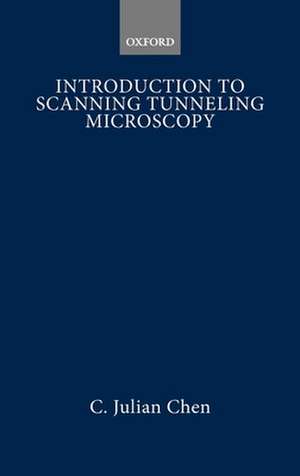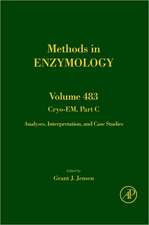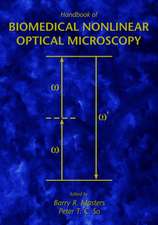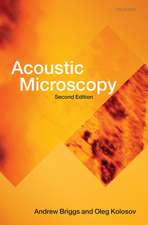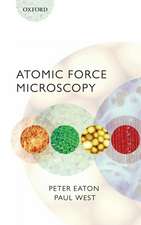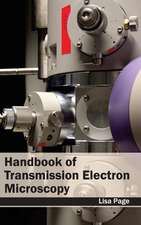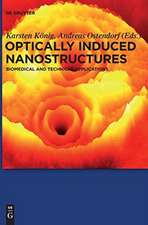Introduction to Scanning Tunneling Microscopy: Oxford Series in Optical & Imaging Sciences, cartea 4
Autor C. Julian Chenen Limba Engleză Hardback – 31 mar 1993
| Toate formatele și edițiile | Preț | Express |
|---|---|---|
| Paperback (1) | 387.19 lei 31-37 zile | |
| OUP OXFORD – 16 dec 2015 | 387.19 lei 31-37 zile | |
| Hardback (1) | 999.27 lei 6-8 săpt. | |
| Oxford University Press – 31 mar 1993 | 999.27 lei 6-8 săpt. |
Preț: 999.27 lei
Preț vechi: 1368.86 lei
-27% Nou
Puncte Express: 1499
Preț estimativ în valută:
191.21€ • 200.20$ • 158.60£
191.21€ • 200.20$ • 158.60£
Carte tipărită la comandă
Livrare economică 09-23 aprilie
Preluare comenzi: 021 569.72.76
Specificații
ISBN-13: 9780195071504
ISBN-10: 0195071506
Pagini: 412
Dimensiuni: 156 x 234 x 25 mm
Greutate: 0.84 kg
Editura: Oxford University Press
Seria Oxford Series in Optical & Imaging Sciences
ISBN-10: 0195071506
Pagini: 412
Dimensiuni: 156 x 234 x 25 mm
Greutate: 0.84 kg
Editura: Oxford University Press
Seria Oxford Series in Optical & Imaging Sciences
Descriere
Descriere de la o altă ediție sau format:
The scanning tunneling microscope and the atomic force microscope, both capable of imaging and manipulating individual atoms, were crowned with the Nobel Prize in Physics in 1986, and are the cornerstones of nanotechnology today. The first edition of this book has nurtured numerous beginners and experts since 1993. The second edition is a thoroughly updated version of this 'bible' in the field.The second edition includes a number of new developments in the field. Non-contact atomic-force microscopy has demonstrated true atomic resolution. It enables direct observation and mapping of individual chemical bonds. A new chapter about the underlying physics, atomic forces, is added. The chapter on atomic force microscopy is substantially expanded. Spin-polarized STM has enabled the observation of local magnetic phenomena down to atomic scale. A pedagogical presentation of the basic concepts is included. Inelastic scanning tunneling microscopy has shown the capability of studying vibrational modes of individual molecules. The underlying theory and new instrumentation are added. For biological research, to increase the speed of scanning to observe life phenomena in real time is a key. Advances in this direction are presented as well. The capability of STM to manipulate individual atoms is one of the cornerstones of nanotechnology. The theoretical basis and in particular the relation between tunneling and interaction energy are thoroughly presented, together with experimental facts.
The scanning tunneling microscope and the atomic force microscope, both capable of imaging and manipulating individual atoms, were crowned with the Nobel Prize in Physics in 1986, and are the cornerstones of nanotechnology today. The first edition of this book has nurtured numerous beginners and experts since 1993. The second edition is a thoroughly updated version of this 'bible' in the field.The second edition includes a number of new developments in the field. Non-contact atomic-force microscopy has demonstrated true atomic resolution. It enables direct observation and mapping of individual chemical bonds. A new chapter about the underlying physics, atomic forces, is added. The chapter on atomic force microscopy is substantially expanded. Spin-polarized STM has enabled the observation of local magnetic phenomena down to atomic scale. A pedagogical presentation of the basic concepts is included. Inelastic scanning tunneling microscopy has shown the capability of studying vibrational modes of individual molecules. The underlying theory and new instrumentation are added. For biological research, to increase the speed of scanning to observe life phenomena in real time is a key. Advances in this direction are presented as well. The capability of STM to manipulate individual atoms is one of the cornerstones of nanotechnology. The theoretical basis and in particular the relation between tunneling and interaction energy are thoroughly presented, together with experimental facts.
Recenzii
The book Introduction to Scanning Tunneling Microscopy by C. Julian Chen serves as an excellent starting point to familiarize newcomers with the field, and at the same time provides an in-depth account of theoretical and practical aspects of SPM for the more experienced user. In my personal experience it is also very useful as a textbook for teaching single-molecule studies, at both the beginners and the advanced level.
Notă biografică
C. Julian Chen, Department of Applied Physics and Applied Mathematics, Columbia University, New York, USA.
